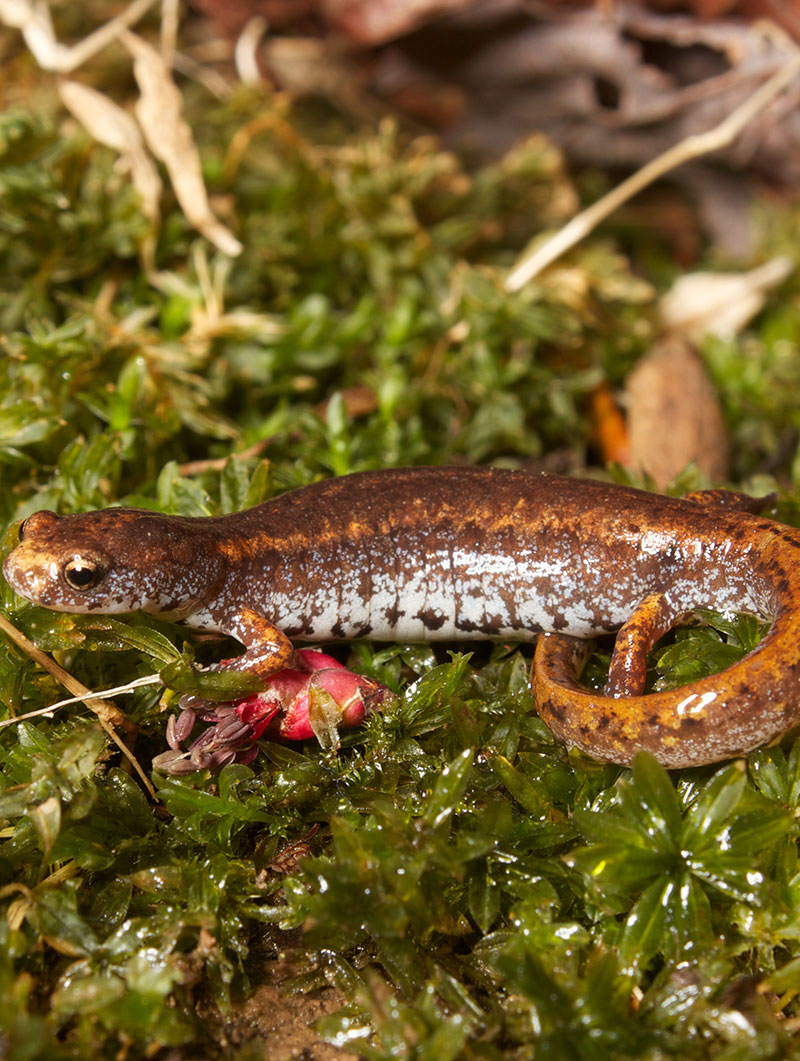Four-toed salamander
Hemidactylium scutatum
Description:
A four-toed salamander is brown or reddish-colored on its back with flecks of silver on its sides. It has a white belly with a random pattern of small, black spots. Its tail is constricted in the place where it can break off if the salamander is threatened. This is the only terrestrial salamander with four toes on each foot. Juveniles are legless and breathe underwater with gills.
Size:
A four-toed salamander measures 2-4 inches (5.1-10.2 cm) in length.
Adaptations:
- Salamanders have slimy, semi-permeable skin that secretes mucus and allows the animals to absorb moisture.
- Salamanders are able to re-grow limbs and tails that may be lost in encounters with predators.
- The color of the four-toed salamander helps it to blend in with leaf litter found on the ground.
- If a predator attempts to eat a four-toed salamander, the salamander can release a mildly toxic, distasteful substance to discourage the predator.
Diet:
In nature, four-toed salamanders consume small invertebrates including spiders, flies, beetles, ants and caterpillars. At Cosley Zoo, the salamanders are fed fruit flies.
Reproduction:
Four-toed salamanders breed in the fall or spring, usually during a rain. The female lays a clutch of up about 30 eggs which attach to plant material (often moss) at the edge of a pool or spring. The female will then guard the eggs until they hatch six to eight weeks later. Sometimes several females will lay their eggs in the same location and share in the guarding of the eggs. The young larvae are legless, have gills, and are unable to leave the water. Over the next six weeks, the larvae will become terrestrial (living on land).
Shelter and space needs:
Four-toed salamanders are found sparsely throughout the eastern United States, including Illinois. They have specific habitat requirements, inhabiting forests which contain bodies of water such as ponds or bogs for breeding grounds. During the winter, four-toed salamanders survive by burrowing underground or sheltering inside rotting logs, often huddled together in groups.
Life expectancy:
Difficult to assess in wild populations. Individuals have been known to live up to nine years in human care.
Relationship with man:
Salamanders and other amphibians are known as “environmental indicators” because they are extremely sensitive to changes in the environment. A high mortality rate or an increase in birth defects can be a sign that an area is becoming polluted. Serving as both predators and prey animals, four-toed salamanders play an important role in the health of forest ecosystems.
Four-toed salamanders are listed as a threatened species in Illinois, primarily due to habitat destruction.
Fun Facts:
- If threatened, a four-toed salamander can curl and raise its tail above its back, tempting the predator to bite at the tail, which the salamander can then drop off in order to escape.
- Scientists are studying how salamanders regenerate their limbs, hoping to apply that knowledge to human health care.
- The word “salamander” comes from the Greek word for “fire lizard”. Salamanders often make their homes in logs. As ancient people threw logs into a fire, the salamanders would run out to safety. This gave rise to the idea that salamanders were born from fire.






